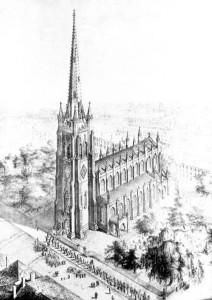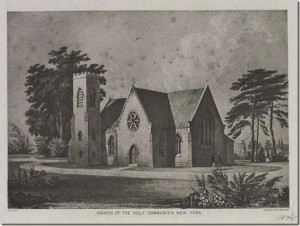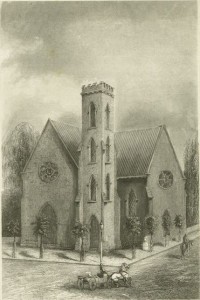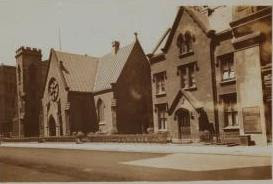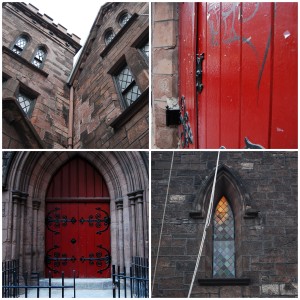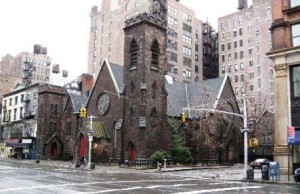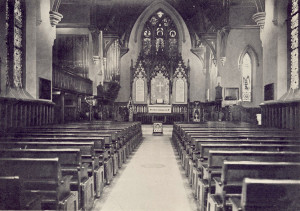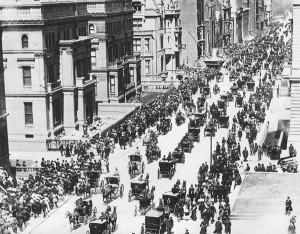To return to the life and times of the Reverend Francis Effingham Lawrence.
The Church of the Holy Communion
As our never-failing source Wikipedia says:
The Gothic Revival church building was constructed in 1844-1845 according to a design by Richard Upjohn, and was consecrated in 1846. In 1853 Upjohn completed the Parish House and Rectory on West 20th Street, and in 1854 he built the Sister’s House.[The design of the church, which features brownstone blocks chosen for placement at random, made the church “one of the most influential buildings of the 19th century”. It was:
[the] first asymmetrical Gothic Revival church edifice in the United States … Upjohn designed the building to resemble a small medieval English parish church … The church’s founder, the Reverend William Muhlenberg, a leader of the evangelical Catholic within the Episcopal Church, was closely involved with the design …
Muhlenberg believed that the Gothic style was “the true architectural expression of Christianity.”
Another source elaborates:
Land was procured on the northeast corner of Sixth Avenue and West 20th Street, at that time a second-rate residential district surrounded by fields. On July 25, 1844, the cornerstone was laid for a church designed by Richard Upjohn and built from 1844-1846. Upjohn’s small building resembled a small medieval English parish church and was noted for being the first asymmetrical rustic Gothic Revival edifice in the United States, a design that would be copied by many churches throughout the country. Dr. Muhlenberg, a leader in the evangelical Catholic movement of the Episcopal Church, was closely involved with the design, suggesting the use of transepts and other features that were more typical of Roman Catholic churches.
Richard Upjohn (1802-1878) designed Trinity Church on Wall Street. It is formal and symmetrical.
Trinity before the canyons were built.
But he made the Church of the Holy Communion asymmetrical and less elaborate, presumably in keeping with Muhlenberg’s desire to welcome both rich and poor, like the village churches of England. The asymmetrical tower inspired numerous Episcopal churches in the United States.
This view romantically portrays the location of the church as it should have been.
This is the church as it in fact was in the 1860s.
Here is an older view, probably in the heyday of the church.
Here you can see how Upjohn used brownstone to give an informal, rustic effect.
And how it looks today.
Here is the interior in 1946.
Muhlenberg, like the Ritualists of England, used Catholic paraphernalia to appeal to the poor, who found bare churches and hour-long Calvinist sermons a touch on the cold side. He thought that the poor should be served with grace and beauty.
The Church of the Holy Communion was the first church to use flowers on the altar, and after the Easter service the congregation in procession brought the flowers to the sick in the hospital the church had founded. This seems to have been the origin of the New York custom of the Easter Parade. Other churches took up the custom of Easter flowers; as Francis Lawrence said in thus funeral sermon of 1877, it was –“a practice now indeed carried to such a silly and wasteful extreme, many churches seeming rather flower-shops at Easter than Sanctuaries of the Almighty, that he almost regretted that he had introduced the custom.”
And the Easter Parade no longer was in service to the poor:
In your Easter bonnet, with all the frills upon it,
You’ll be the grandest lady in the Easter parade.
I’ll be all in clover and when they look you over,
I’ll be the proudest fellow in the Easter parade.
On the avenue, Fifth Avenue, the photographers will snap us,
And you’ll find that you’re in the rotogravure.
